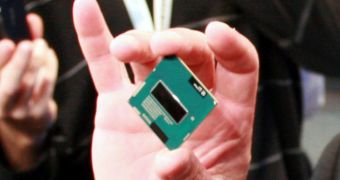Intel’s integrated GPUs have always suffered from lack of decent performance, acceptable driver compatibility, stability and image quality. Lately, there have been many rumors creating high expectations for next year’s graphics unit integrated in Intel's Haswell CPU.
Semiaccurate’s Charlie Demerjian is reporting that the fastest Haswell GPU, the GT3 variant, will sport 64 MB of on-package GPU memory on an interposer connected through an ultra-wide bus.
Now called Crystalwell, this tech will prove very expensive for Intel in the initial stages.
There was much speculation about some sort of L4 cache on an MCM module or something similar, but that made little sense.
Cache-ing the whole CPU has no real point in a context where you have a single socket in a PC, laptop or workstation.
There is no cross talk between sockets and memory controllers, no coherence data, and generally no such high latency between the CPU and the main memory that would require the former to use a Level 4 cache.
Still there were reports about an expected high level of performance and everybody searched for an explanation.
Ever since Intel launched CPUs with integrated GPUs, the performance was indeed lacking but, with each new generation, it went up very fast. It went from Intel HD 2000’s 6 shaders to HD 3000’s 12 shaders, and from a lower clocked version to a faster one.
The future Intel HD 4000 will only have 16 shaders. A very small 33% increase from HD 3000’s 12 shaders when compared to a 100% increase marked by the HD 3000 versus the old HD 2000.
Even so, the performance will be there as promised, because HD 4000 is a completely redesigned architecture, and each of the 16 shaders is much more capable than the units in the HD 3000. This will help Intel demonstrate its claim of 100% increase in performance.
However, from HD 4000 to Haswell’s GPU, it seems that Crystalwell is the technology that will make the difference.

 14 DAY TRIAL //
14 DAY TRIAL //